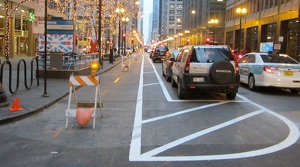
just in time for holiday shopping.
(Photo: Green Lane Project)
Like New York before them, Chicago has just taken a major step forward in becoming a city where biking is given equal respect to driving.
Advocates are buzzing today as the Chicago Department of Transportation has striped a new, two-way bikeway on N. Dearborn St between Polk and Kinzie. That’s a segment of over one mile on a high-profile downtown street in one of America’s largest cities.
“That’s huge and symbolic,” tweeted Portland Mercury News Editor Denis Theriault upon hearing the news, “[Would] Be like putting one here on Washington or Everett.”
Yeah. If only.
While excited by what’s happening in Chicago (and D.C., and San Francisco, and so on), I can’t help but think how great it would be if Portland could muster something this big.
Tonight, the director of the Green Lane Project will host a panel discussion with local transportation officials about how to bring world-class bikeways to Portland. It’s a talk, which is something we’ve done an awful lot of the past several years. Unfortunately, when it comes to protected bike lanes downtown, we haven’t seen much action.
Mayor Adams came into office guns a’ blazing, with a promise for a downtown cycle track within his first “100 days.” He lived up to that promise, but a few blocks of curbside bike lanes protected by parked cars on SW Broadway that leaves users in a lurch at both ends has hardly been a game changer.
“The Dearborn Street two-way protected bike lane project will balance roadway space to ensure pedestrians, transit users, bicyclists and motorists can travel along and across the street safely.”
— Gabe Klein, City of Chicago
In Chicago, Mayor Rahm Emanuel has re-allocated a lane of the roadway to make room for the new protected lanes. The design of Dearborn is a two-way bikeway that is protected from moving traffic by parked cars. Along with the new striping are new bicycle traffic signals at every intersection to manage traffic flow.
In an official statement, head of Chicago DOT, Gabe Klein said, “The Dearborn Street two-way protected bike lane project will balance roadway space to ensure pedestrians, transit users, bicyclists and motorists can travel along and across the street safely.”
Portland has many gaps in its downtown bike network. The streets are out of balance. Each time another U.S. city does a project like this it just becomes more and more obvious that we have plateaued. Beyond the island of protection provided by the Broadway bike lane, the only other bike-centric changes on major downtown streets have come in the form of bike boxes. And, as recently reported, those have had mixed results in preventing right-hooks (and PBOT says people on bikes need to be more careful when riding through them).
It’s clear now that Mayor Adams doesn’t have any major, downtown bike access improvements up his sleeve for his last few weeks in office, so the conversation now is: How can we best help PBOT and City Hall do what needs to be done? We have seen glimmers of hope recently. The bike lane lanes on Stark and Oak have been widened and painted green, and PBOT is putting finishing touches on a major redesign of NE Multnomah (which is not downtown, but is still a noteworthy project).
I’ll hope to hear more reasons for optimism at the Green Lane Project/PBOT event tonight.
— We’ll be talking about the future of bikeway design in Portland and much more at the BikePortland/Lancaster Engineering Wonk Night event tomorrow (12/5) starting at 6:00 pm. I hope you’ll come and add your thoughts to the mix. (Did you hear that Omission Beer is an official sponsor?)



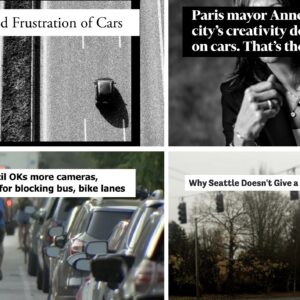
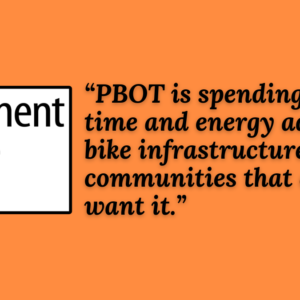
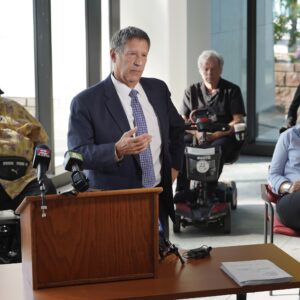
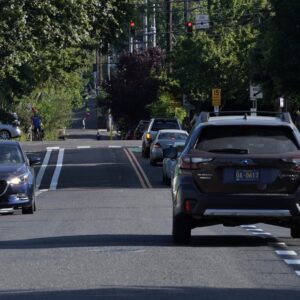
Thanks for reading.
BikePortland has served this community with independent community journalism since 2005. We rely on subscriptions from readers like you to survive. Your financial support is vital in keeping this valuable resource alive and well.
Please subscribe today to strengthen and expand our work.
people need to show up to public meetings about bike infrastructure and say that they want them!
Yes. That’s very important. But I’ve seen a lot of people show up to meetings and ask for stuff, only to be rebuffed when the politics trump what people want. It’s frustrating and it means fewer people will show up next time around (a vicious cycle I’m afraid).
As somebody who has shown up to a lot of public meetings here in Portland over the past three years, I wish I could agree, but find it hard.
Most open houses seem to be little more than tokenistic lip service meetings to fulfill the stipulations of whatever grant funding the projects are driven by. Staff have usually made up their minds long beforehand about what and where the funding is going to be used for.
Unfortunately, the biggest driver of new bike projects seems to require somebody getting killed on a bike. While it is good to see the City taking action after a tragic death (ie green bike boxes), I think it is an important point to note that if the City was busier putting in groundbreaking, safe bike infrastructure proactively, people would not be getting killed in the first place.
My two cents.
Jonathan,
I’d be curious if you could get someone from PBOT to respond to questions like this on a semi-regular basis? It seems like it could be a win for everyone. We wouldn’t need to guess/gripe so much; could understand a little more how PBOT views this; and perhaps the conversation would even knock loose whatever’s jamming up the works.
I second this. I would like to know in particular, why the City still seems so adverse to regular diversion on neighborhood greenways. We need diverters every ten blocks on every bike boulevard. If that question could be put to City staff, I would be very happy.
Regarding diverters, the City’s bike planner Roger Geller once in a presentation said something to the effect of, “Oh, well, we tried those once in the seventies, and it was so reviled by the neighborhoods, we have never tried it ever again”.
UM!
OKAY!
You could argue that point theoretically about practically anything! I’m sure if you had tried green bike boxes, bike corrals, separated cycletracks, rails to trails conversions, bike signals, and HAWK signals in the 1970s, they would have been reviled. It’s no reason not to try it again forty years later!!
I can’t agree more with the need for enhanced traffic calming on some of our so-called neighborhood greenways, including diversion. The ‘greenway’ I am most intimately familiar with is Clinton, but I’m sure the situation is similar on others.
I live a half-block off of Clinton, I ride it frequently, and we walk its sidewalks constantly with a toddler. Automobile traffic has continued to increase over recent years, and it is clear — particularly at rush hour — that a good proportion of it is cut-through / bypass traffic. And the Division reconstruction project hasn’t even started yet. Yet the best the city has been able to muster is some cutesy art installations that were intended to make drivers more “aware” that they are on a bike-focused street.
Now we’re faced with close to a year of impatient, frustrated drivers using Clinton as a bypass around the Division construction, including several weeks when Clinton will be the official detour route when Division has to be closed completely. How many drivers are going to simply ignore the “Detour” arrow sign back to Division and simply stay on Clinton? Let’s see some temporary diverters put in place during the project to stop cars from turning Clinton into an automobile arterial.
washington or everett? what is the urgency on either of these streets?
Agreed. Something like this on NW Broadway or W Burnside would be much more of a breakthrough.
What Rahm accomplishes with an iron fist in Chicago, Portland City Council could accomplish through consensus. What is missing is an elected official actually spending a few bucks of their own political capital and go to bat for it. Shameful.
You must be new here. Consensus-based governments tend not to get anything accomplished, particularly in THIS city. I doubt things will change much over the next 50 years or so, even as the city densifies.
One step we can all take is to start demanding to our Mayor Elect that he announce a detailed plan his first month in office about improvements to our multi-use infrastructure. We want to know what he plans to accomplish in the first 30 days, the first 6 months, the first year, and the first two years.
The thing about politics is in order to accomplish something you can really go about it two ways. You can either A) announce your intentions in advance and count on the citizenship to back you up or B) just ram your ideas through before anyone notices. I would argue that the first option is preferable if you want long lasting change and/or wish to stay in office though there are of course exceptions. In the real world it is probably a balance of the two and politicians have to know which method is going to work.
As much as I like Sam Adams, I don’t think he ever figured out how to use which method at the appropriate time. One of several reasons he didn’t last (made up scandals didn’t help much either).
Don’t forget Stark & Oak though.
Portland is a minor league town now. Sad but, true. NYC, DC, Chicago, and Minneapolis are pulling away. We wring our hands and dream about emulating Copenhagen while other cities forge ahead with original homegrown thinking and pragmatic solutions. They carve systems out of their existing landscapes that can be built now, we vision, or fantasize if you wish, two decades worth of favorable land use planning and eminent domain rulings to get to where we can copy Old World cities that were never built for cars to begin with.
mikeybikey – I’ll disagree with you about the need for consensus. Bloomberg and Emanuel see what they want and go for it. IMHO, Portland is notorious for weak politicians and entrenched bureaucrats that are more concerned with reaching their PERS payoff than building a better city.
I’ve never lived in a city larger than Portland. Is there something about living in such a large metro area that makes these projects more feasible?
Is there less resistance? Less NIMBYism? Maybe so many other things going on that bike transportation policy goes under the radar?
I honestly don’t see why it’s so hard, but I’m not involved with politics at all, so there must be some back-room reason.
Face it, we’re pretty boring here, so our monolithic “biking” special interest group getting away with everything short of murder makes for good news (eyeroll).
In some ways, yes. I think one reason you see NYC, DC, and Chicago doing big things is because 1) they have dynamic/aggressive DOT leadership and mayors that support this stuff and 2) their transpo budgets are massive compared to a little city like Portland. The practical impact of that budget difference is that there’s (obviously) more money to go around. Also, it’s likely easier to do “bike projects” because the money isn’t seen as being “taken away” from other places. Here in Portland, we have so few transpo dollars to spend that there’s intense scrutiny on ever dollar… So when even a small portion of that goes to what some perceive as “bike projects” it makes headlines and people freak out.
More money, maybe, but there is TONS of scrutiny here in NYC. Remember, we have many local tabloids that get their kicks taking swipes at the mayor for pretty much anything, and especially things bicycle related.
Probably the biggest reason for success was the strong mayor system and persistance. The strong mayor system has pretty much the entire bureaucracy under the control of the mayor, which is not the case in many other jurisdictions. Also, the DOT here was strategic in choosing critical projects with local support and persistant is maintaining forward progress, despite often fierce opposition. It took a lot of courage and political support, but it seems we startung to turn a corner here, where new projects don’t generate nearly as much controversy.
That said, we get a new mayor in a year, and none of the presumptive candidates have expressed much support for the biking and walking initiatives begun under Bloomberg, so we may be hitting a plateau in the near future, and it won’t include projects like Multnomah.
Seriously?
Wow, the poor attitudes on this thread are really disappointing me I’ve got to say.
I’m reminded of a quote:
“The more you express gratitude for what you have the more things you’ll have to express gratitude for.”
So Chicago got a 1 mile long two way bike route through their downtown. That is fantastic and I am very happy for the people who will benefit from it. But now Portland is suddenly minor league when it comes to bike improvements? Please…
Have we forgotten that there are currently not one but TWO bridges being built as I type this which feature excellent designs for bike transportation? Did we forget that just this month we got a complete revamp of the Lloyd Center area (which is excellent btw…I’ve ridden on it twice now)? We also got re-striping with a nice wide lane on two major downtown streets.
Now am I saying we should just sit back and be happy with what we get? No, absolutely not. Never. Am I saying we don’t have a right to complain and demand more? Nope, I’m not saying that either. However, a piss poor attitude doesn’t help AT ALL. Snide comments take us backward not forward. It does a lot to hurt the perception of transportation advocates far more than it helps.
i think dearborn in chicago would be more analagous to glisan or 3rd.
i also note that the city of chicago striped a dotted yellow line instead of separating the two narrow lanes with metal grates, poles, and trees.
Where do we separate two-way bike path with grates, poles, or trees (besides dumb bollards at intersections)?
SW Moody, unfortunately. http://swmoodyproject.com/design/
Exactly, that project (Moody), is supposedly what most on here are always clamoring for (separated cycle specific infrastructe). Yes frankly, it kind of sucks. The crossing at sheridan is a disaster, there is a blind spot around that huge pillar, it is very hard to pass other cyclists with the trees etc., and it is apparently really confusing for pedestrians to understand that the lanes are supposed to be bike only. I ride that cyclepath at least once a week, and it’s not much of an improvement at all.
Personally, I just don’t think that separated bike infrastructure is always the go to answer.
And Jonathan, I’m curious how starting and ending into/ out to a designated bike lane is “leaving riders in a lurch” on Broadway? How else would you connect that cycletrack at the ends?
Our “platinum” designation is looking more embarrassing by the minute. LAB, please strip us of this unwarranted albatross!!!
I concur…I have made this recommendation for other cities too…
Typically LAB reviews these award levels each reapplication period…so a city could potentially be evaluated and found to be at a lower grade level (just as they were evaluated and found to be at a higher level before)…having said this the recent addition of a new highest tier above platinum and fund raising politics makes demoting a city like Portland pretty tough unless PBOT really turned its back on things bike.
Dearborn’s not quite the workhorse in Chicago that State, Clark, LaSalle, Madison, Michigan, or Congress are. But it’s still prominent and well traveled. So I groped for a PDX analog. Gonna have to borrow a bike next time I get back to my ol’ hometown.
Jonathan
I am interested on your take regarding the Green Lane event last night–take the whole audio snaffu out of the picture–which was a lingering distraction—you walk a way with little here. A question that was posed still resonates with me “Can the city reach a 25% bicycle mode split based on a low hanging fruit strategy” For those of you not in attendance last night, the answer from PBOT was “probably no”. The issue for me is completion of a a single protected bikeway (no gaps and no kinks) linking destinations beginning and end of story. Two streets in mind (pick one) would have a profound and major impact on ridership and would be highly visible– Burnside and Broadway. As a teaser–just to test it out– how about Sunday Parkways- EASTSIDE MEETS WESTIDE we kick off the ride at Pioneer Court House Square. The route– SW 6th to Burnside–Burnside to 32nd/33rd– 33rd to Broadway– Broadway back to Pioneer Court House Square
Its easy… I just put on a map– Whose with me?
Overall, I was unimpressed. It was mostly stuff we have all heard before and I still can’t help notice the irony of timing. Another panel discussion to talk about what Europe does/what we should be doing/why we aren’t doing it yet, while other cities are out laying down major bikeways through their cities.
I think a lot of Portlanders have tired of this type of event. We’re ready for action. Not more words and excuses.
Jonathan-
Now living in Chicago and using Dearborn as part of my regular five mile commute home to Lakeview (the improved lane is so new I’ve been traveling for work and haven’t ridden it yet), I would like to caution that infrastructure does not a biking city make.
By-in-large Chicago is not particularly bike friendly and in my opinion did not deserve its Bicycling Magazine #5 ranking.
While infrastructure is still problematic in places (crossing the river in numerous places, direct routes, bike lanes that disappear), the biggest problem in Chicago is behavioral. Cyclists, both commuters and fixie-festooned hipsters, do not obey traffic law. At all. Drivers have a very low cyclist IQ and cyclists only reinforce other road users’ frustration and confusion. Every morning I’m the only helmeted rider actually stopped at lights heading south on Clark. Riders that use lights or wear helmets are a minority. When I see someone with both I’m pleasantly surprised.
The motorists, cyclists and the City would be much better served AND get a better safety bang-for-its-buck by spending these dollars on education (frequent and ubiquitous) and enforcement (sparingly and strategically).
Were I to hazard a guess–many of the early projects happened without any substantial opposition. Now that Portland has gotten a lot of press, and budgets are tight, there is now a much larger cohort of whining motorists (and business owners convinced that the only customers worth having come in cars), and thus such projects are now less politically easy.
Certainly the freight lobby seems to view bike projects as competition for transportation dollars; and the “war on the cars” rhetoric has been ratcheted up.
It could also be the simple case that the low-hanging fruit have been picked, and that what remains are technically or politically more difficult projects.
Portland – “The City That Meets”
Portland does a lot of boasting, and there is some good things for bikes around inner NE and SE Portland. Support is pretty poor in other less popular parts of town. Maybe Hales can do what Adams didn’t, but I’m not holding my breath. We get the same old politics in Portland over and over again.
Seriously. I moved here from NYC four years ago for the biking. As soon as I did the tables turned.
I moved here from Chicago 2 years ago. I’m not jealous because no matter what Chicago does design-wise, it doesn’t make December through March any less horrifying to ride in. I’ve done it and no amount of innovation softens the wind and cold.
Chicago has a pretty ambitious plan for cycling. The mayor is adding 20 miles of bike lanes every year.
The wind and cold arefading away with global warming. Can’t wait to ride this two way and signaled bike lane!
Chicago’s mayor Emanuel proudly read your headline here in his ribbon-cutting comments today.